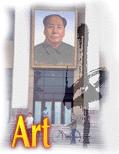|

 Painting Painting

Traditional Chinese Painting ( Zhongguo Hua ) ( Zhongguo Hua )
| [ Prev ] Many a Chinese painter is at the same time a poet and calligrapher. He will often add a poem in his own hand on the painting, which invariably carries an impression of his seal. The resulting piece of work is usually an integrated whole of four branches of Chinese art-poetry, calligraphy, painting and seal-cutting.
Chinese paintings are divided into two major categories free hand brushwork (xieyi) and detailed brushwork
(gongbi). The former is characterised by simple and bold strokes intended to represent the exaggerated likeness of the
objects, while the latter by fine brushwork and close attention to detail. Employing different techniques, the two schools
try to achieve the same end, the creation of beauty.
It is difficult to tell how long the art of painting has existed in China. Pots of 5,000-6,000 years ago were
painted in colour with patterns of plants, fabrics, and animals, reflecting various aspects of the life of primitive clan
communities. These may be considered the beginnings of Chinese painting.
China entered the slave society about 2000 B.C. Though no paintings of that period have ever come to light,
that society witnessed the emergence of a magnificent bronze culture and can only be taken as a composite art of
bronzed
|
 |
paintings and sculptures.
In 1949 from a tomb of the Warring States Period (475 - 221 B.C) was unearthed a painting on silk of human figures,
dragons and phoenixes. The earliest work on silk ever discovered in China, it measures about 30 cm long by 20 cm wide.
From this and other early paintings on silk it may be easily seen that the ancients were already familiar with
the art of the writing or painting brush, for the strokes show vigour or elegance whichever was desired. Paintings of
this period are strongly religious or mythological in themes.
Paintings on paper appeared much later than those on silk for the simple reason that the invention of silk
preceded that of paper by a long historical period.
In 1964, when a tomb dating to the Jin Dynasty (265-420 A. D. ) was excavated at Astana in Turpan, Xinjiang, a
coloured painting on paper was discovered. It shows on top, the sun, the moon and the Big Dipper and below, the owner of
the tomb sitting cross-legged on a couch and leisurely holding a fan in his hand. A portrayal in vivid lines of the life
of a feudal land-owner, measuring 106.5 cm long by 47 cm high, it is the only known painting on paper of such antiquity
in China.
|
[ Back ]


|